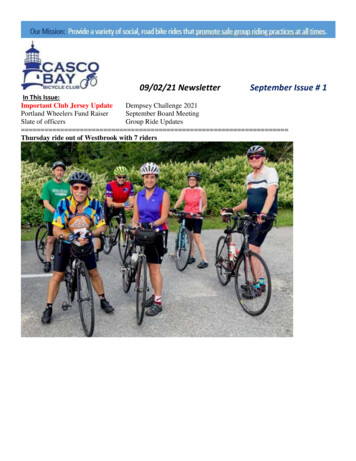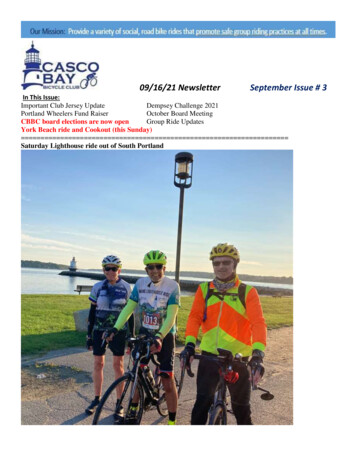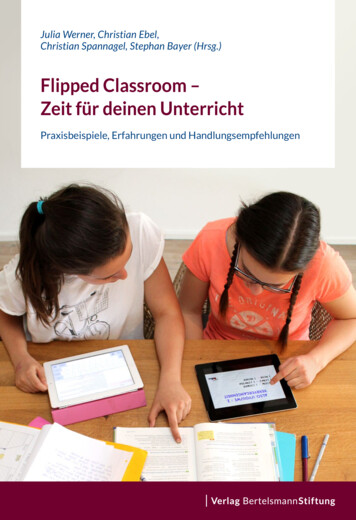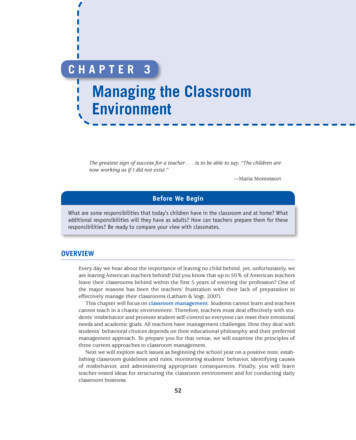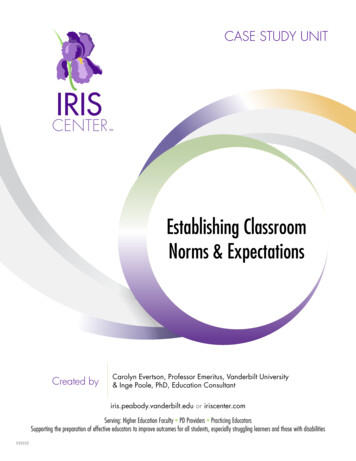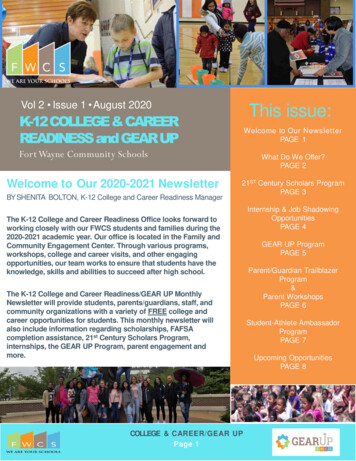
Transcription
ClassroomphysicsThe magazine for IOP affiliated schoolsOptics of aglass of waterOnline teacher CPD – the way forwardCelebrating 60 years of the laserYour Future with Physics: our new careers hubiop.orgSeptember 2020 Issue 54
EditorialClassroom physics September 2020News3What is online teacherCPD like?4Early career teacher support5Your future with physics:our new careers hubPhysics CPD –looking forward from lockdownCredit: IOP/ShutterstockThis issueFeatures6Challenging commonmisconceptions7Cognitive load theory –some strategies to teach lightResources8Online self-study, motivationand student engagement9Optics of a glass of water10-12ActivitiesDigests14-15Physics Education16TalkPhysics & Physics World17STFC laser resources &CLEAPSS guidanceLasers: Stories from Physics& Marvin and Milo18Listings19Opportunities20IOP CPDEditorCaroline Daviscaroline.davis@iop.orgPhysics pull-outTaj Bhuttataj.bhutta@iop.orgPhotographyDan Josman2For well over a decade, IOP has providedphysics CPD at no cost to teachersand technicians across the IOP nations(England, Ireland, Northern Ireland,Scotland and Wales). Almost all of thishas been face to face. Whilst we had beendeveloping plans to introduce more onlinesupport, COVID-19 forced us to acceleratethis move significantly.We were pleased to see that the mostdeprived schools seemed to be accessingmore CPD than others; those schools in thehighest quartile by percentage of studentswith free school meals accounted for 33% ofour CPD provided to state schools. Overall,over 90% of uptake was from teachers instate-maintained schools and 44% camefrom schools with above average uptake offree school meals.After an intense four months deliveringonline CPD, the end of the school year gavean opportunity to reflect.We hope that the move online has beenpositive. It eliminates barriers such as traveltime and cost, but we know that otherbarriers remain: internet access can bea limit for some, as well as caring/familycommitments or employer permission forsessions during school hours.We have been delighted to see hundreds ofschools engaging, many for the first time.Between April and July, we ran over 300online sessions - more than 3 sessions perweekday on average - providing over 5,000teacher-hours of training. Most attendeeswere teachers or technicians from the homenations, but we also welcomed colleaguesfrom around the world along with supplyteachers, education consultants and thoseproviding initial and in-service trainingfor teachers. Repeat business might beconsidered a sign of success: most schoolsattended three or more sessions and manyattended dozens.We do hope you (and your colleagues) will beable to join us over the coming year.Find out more about our CPD programmefor this autumn term on the back page.Please complete our online survey to helpus understand and tackle the barriers toCPD participation.bit.ly/IOPcpdsurveyNow, perhaps more than ever, it’s importantto ensure our support is directed towardsthose students in the greatest need.With this issue.Stories from PhysicsTwo booklets because wemissed one in JuneIOP Education Stories from physics booklet 4Waves:light, soundandotheroscillationsIOP EducationStories fromphysicsbooklet4By Richard BrockWaves: light, sound and other oscillationsBy Richard BrockLaser pointerCelebrate 60 years of lasersLaptop badgeBe proud of who you areiop.orgiop.org
NewsClassroom physics September 2020What is online teacher CPD like?We had been facilitating teacher CPD face-to-face for many years when we rapidly had to switch to online sessions. So how different was theexperience - and was it still worthwhile? Three attendees give their verdict.“A great opportunity toparticipate in CPD”“The chat box in the corner wasmost valuable”Online sessions enabled me to participate inCPD I would not normally due to funding orgetting time off. I ended up attending severalsessions and pulled in other members of mydepartment. Everyone came back with ideasthat we have put into our schemes of work.Despite not being able to physically try theexperiments, the presenters did an excellentjob of producing props, presentations andvideos so we could see how they worked.In the strangest of all summer terms, Inervously found myself signed up for athree-day virtual physics fest. Every sessiongave me something to think about. Was itthe same as being there in person? Sadly,no. But the chat box in the corner was mostvaluable. It silently, but rapidly, filled withideas, explanations and links from membersof the audience, giving this whole process theedge over any live session.Laura (physics teacher)Sharon (science teacher)Physics teaching andlearning resources forremote studyAs Classroom Physics went to print, allstudents were expected to be going backto school. However, with local lockdownsbecoming common-place, it is not impossiblethat students will have periods of home-“Fabulous! But no biscuits”The main difference was not being sat at atable with a nice cup of tea and a plate ofbiscuits. When you do that, you learn muchmore than the ‘official’ CPD because youcan talk to everyone else. The IOP did afabulous job of mitigating this by having IOPcoaches monitoring the chat, so we couldhave conversations. I met people I’m now incontact with via Twitter and it was great tosee some familiar faces.Helen (physics teacher)learning. So here is a reminder of the physicsteaching and learning resources we havedeveloped for this purpose. They can all beaccessed from:spark.iop.org/covid-19Resources by physics topicYou can also browse by resource type within these collections1. Earth and Space4. Forces and Motion2. Electricity and Magnetism5. Light, Sound and Waves3. Energy and Thermal Physics6. Properties of Matter7. Quantum and Nuclear PhysicsResources by age range11 – 14 year olds14 – 16 year olds16 – 19 year oldsResources by type1. Videos to watch at home2. Home experiments3. Questions to checkunderstanding and identifymisconceptionsFollow the IOP Education Department on Twitter @IOPTeachingLive online events3
NewsClassroom physics September 2020Early career teacher support in the wake of lockdownCredit: IOPDespite the current uncertainties, this year wehave seen a significant increase in the numberof people applying to the IOP teacher trainingscholarship scheme. We are also pleasedto have been able to award considerablymore scholarships to prospective teachersembarking on initial teacher education thisSeptember compared to last.In the past months, we have consultedteacher trainers to find out their concerns.These centred around the need to supportthe current cohort in September with areduced timetable and subject-basedsupport, to avoid even higher dropout ratesthan normal. Placements for the next cohortwere another significant concern, both interms of schools being unwilling to providethem, and possible limited duration.Reciprocalagreement for IOPand ASE membersDid you know that current ASEmembers can join the IOP at a 30%discount on the full annual rate fornew memberships? And IOP memberscan claim a 30% discount on theirfirst year of membership with ASE.more.Visit membership.iop.org/reciprocal agreementsto find out moreWe are continuing to work with ITEproviders and the teaching community todeliver the extra support new teachers mayrequire. Additionally, we have partnered withother organisations to communicate theseissues to government to find ways to providethe resources.This academic year, we are putting in placea comprehensive programme of teacherCPD which will include sessions specificallydesigned to address these needs. MarkWhalley, IOP Education Manager said, “Wewill have regular online CPD sessions whichare dedicated to new and early careerteachers. Our coaches will provide subjectknowledge workshops and teaching supportas well as making themselves available tooffer advice direct to participants.”Calling trainee science teachers!Being part of the IOP community canbe of great benefit to trainee scienceteachers, whatever their specialism.This year, we want to keep in touchwith as many people startingthis journey possible. We’ll shareevents, CPD, support opportunitiesand our resources. Please forwardthis registration url to any traineeteachers you know:iop.org/student-teacherGreat Science Share: wherever they are!The 5th Great Science Share for Schoolssaw registrations for over 90,000 youngpeople aged 3-14 years with over half ofthese signing up during lockdown. Thisannual campaign has now reached over200,000 youngsters in 12 countries,nurturing them to share scientificquestions with new audiences.Many families got involved for the firsttime this year and teachers and parentshave found the value in engaging with thecampaign to raise the profile of scienceand increase engagement with a growingaudience in secondary schools.Credit: Great Science ShareWhilst ultimately it is students whoseeducation has been most disrupted byschools closing their doors, it is importantto remember that student and early careerteachers may also have had setbacks totheir professional development.Last year, the number of new physics teacherswas particularly low. At the start of September,UCAS reported that just 520people entered postgraduate initial teachereducation in physics. According to the latestUCAS data, this year, 550 people haveaccepted places on ITE courses (final figuresare likely to be slightly higher).more.Explore the science shared by visitinggreatscienceshare.org/showcase and follow@GreatSciShare on Twitter to find out aboutthe 2021 Great Science Share.4“We made a teddy zip line, finding out what gradient andmaterials worked best. Lots of fun!” Owen shares hisGreat Science Share investigation
NewsClassroom physics September 2020Your Future with Physics:our new careers hubHelp us get moreyoung peoplechoosing physicsThe IOP is launching its first publicfacing influencing campaign withthe aim of increasing the number ofyoung people who study physics, orstart an apprenticeship, from age 16.Credit: IOPOur campaign is especially focusedon young people who areunderrepresented in the physicscommunity and who may be deterredfrom choosing to do physics becauseof the barriers and stereotypes thatthey experience.“Physics gets a bad rep because people think it’s really hard and so they shy away from it – especially girls. Being asuccessful musician is hard, but people aspire to do that. It’s just a matter of realising that it’s not out of your reach.”Advice from Yolanda, post-doctoral researcher into MRI techniques to look at the brain.The IOP has launched a new online hubdedicated to exploring the wide range ofoccupations and careers that a physicseducation can lead to. Your Future withPhysics has user-friendly menus to guidevisitors through a world of informationfor secondary school students and theirparents, carers and teachers.Censuswide surveyed 500 hiring managersfrom across the UK’s professional sectors,including charities, legal, sales, media andmarketing. One recruiter said: “When I seephysics on a CV, it indicates strong generalknowledge, a deep-thinker and the abilityto make decisions objectively - all valuableassets in my workplace.”On the hub, young people tell the stories oftheir career journeys to date, explaining whythey made the choices they did and howtaking physics made a difference to them.Rachel Youngman, deputy chief executive atIOP said: “This research shows that havingphysics on CVs helps young people to gettheir foot in the door when applying for rolesand makes it more likely that they will standout from other candidates.”New and alternative routes into careers, suchas through apprenticeships and technicalqualifications are also described, explainedand demystified through interviews and chatwith young men and women who have takenthese routes, both in physics and beyond.The hub launched as the IOP revealed theresults of a recently commissioned survey,which showed that 78% of employers hada positive impression of an applicant withphysics at A-level or above on their CV.more.Share your story atiop.org/your-storiesMyPhysicsCourse –updated for 2021 entryShe continued, “Physicists work in everysector, from solutions to climate change,creating the latest technologies in cancerdiagnosis, AI and video gaming, to the publicsector and traditionally non-scientific sectorsincluding charities, sales and banking.“We hope our new digital resource willinspire parents, carers and young peopleabout the opportunities that the study ofphysics will bring.”more.iop.org/your-physics-futureCredit: IOPAdvice on A-levels, Scottish Highers and IrishLeaving Certificate choices is illustrated bythe accounts of students who describe howthey made those choices themselves, andthose in higher education explain how theydecided which universities to apply to.Members of the physics communityhave been sharing their experienceswith us and their compelling storieswill powerfully illustrate why change isneeded. If you also had to overcomechallenges to pursue physics whenyou were younger, we would be verygrateful if you would share yourexperiences with us.Our hub for undergraduate physics degreesin the UK and Ireland is ready for yourstudents. As well as listing all courses, itgives advice about entry requirements,subject combinations and costs so is suitablefor those still choosing their post-16 optionsas well as students who are at the next stageand choosing where to study.myphysicscourse.iop.org5
FeaturesBy the time a student arrives in a physicsclassroom, they’ve had over a decade’sworth of experience of interacting withphysics in the real world and formingtheir own ideas about how physicsworks. Research has shown that takingthese student ideas into account greatlyimproves teaching efficacy.And after a break from formal schoolingthat your students had only ever dreamedof before Covid, your task of identifying andaddressing misconceptions is likely to bea challenge.We have a developed a collection of thecommon misconceptions and exploredchildren’s thinking discussed in the academicliterature with leading researchers. Youcan access them on IOPSpark, our teacherresources website. Each misconceptionincludes diagnostic tools, resources toaddress the problem and a list of referencesto follow if you would like to know more.However, only you can make the decisionsabout what is most appropriate for yourclasses and students. We hope that byshowing a range of ideas that children canhold in each physics domain, andpresenting these alongside researchinformed resources, will support the use ofevidence in physics teaching.This is an ongoing project and we areconstantly adding more content.more.Browse our collection of misconceptionsMisconceptions research and isconceptions-blogs6Credit: Martyn Win for Spacex/ University of ExeterChallenging commonmisconceptions whenteaching physicsClassroom physics September 2020Using IOPSpark misconceptionsWe currently have over 120 misconceptions covering four domains of physics: Light, sound and wavesForces and motion Electricity and magnetismEnergy and thermal physicsAlongside them, we also have a toolkit of articles to help you think about how to usethe content.Assessing pupil thinkingDeveloping curriculaSubstantial evidence suggests that theholding of misconceptions can preventpupils’ further understanding of physics.Suppose we were teaching Newton’sSecond Law, and came across thefollowing misconception: “Many pupilsare unable to apply Newton’s SecondLaw to examples of motion in 2D.” Nowwe are aware of this potential stumblingblock, we could assess pupils’ thinkingby asking them to explain, discuss ordraw the motion of a bowling ballbeing thrown out of a horizontallymoving aeroplane.Whether you’re a technician, a teacher,the head of your department, orsomeone involved with the runningof a school or a multi-academy trust,you are an important part of thecurriculum-making process. After all,curriculum development doesn’t startand end with a national curriculum:interpreting and structuring its content,planning and teaching lessons, andmanaging the context in which studentslearn (through, for example, the use ofpractical activities) all have a profoundimpact on learners’ understandingof physics.Developing pupil thinkingOnce you have a clearer picture ofthe sorts of ideas your pupils mighthave about physics, the next questionto consider is: how can you helpdevelop these ideas to challengemisconceptions and deepen theirunderstanding of physics? The processby which concepts develop continuesto be a topic of active research for theeducation community. We examinefour approaches: coherence,knowledge in pieces, competingconcepts and sociocultural.Developing your own understandingof physicsOne of the benefits of familiarisingyourself with common studentmisconceptions is that it may help todevelop your own knowledge too! TheIOPSpark misconceptions resourcesmay improve your physics contentknowledge by simply filling in any gapsyou might have. With the growing needfor physics teaching to be carried out byteachers whose specialism is in anothersubject, it is entirely understandablethat some teachers of physics may findthemselves grappling with their ownmisconceptions from time to time.
FeaturesClassroom physics September 2020Cognitive load theory – some strategies to teach lightIn the last few years, cognitive load theory(CLT) has been receiving a lot of attentionby educators and has started to shape theclassroom practice of many teachers.So, what is CLT? Alessio Bernardelli, amember of the IOP’s Professional PracticeGroup, explainsThe simplest way to think about it is thatcognitive load is the heavy lifting the brainhas to do when completing tasks. If you canreduce the cognitive load of the task, thelearner can focus on the relevant information.The value of cognitive load theory is thatit helps us sequence and design activitieswhich are well suited to learning more andlearning to solve problems. Reducing thecognitive load of a task means students canfocus on the important concepts and learnmore efficiently.It is inefficient to continue with new learningunless this knowledge is secure. This cantake several lessons. So before moving on tothe next stage of the learning, this knowledgeneeds to be well embedded. Quizzing is avery effective way to do this, as is comparingsimilarities and differences.Graphic OrganisersWorking memoryAn example to reduce the cognitive loadwhen reading about refractionAir is less dense thanwater so light travels fasterYour working memory is your thinkingworkspace. It can only really cope withtwo or three new things, but it can draw onpreviously learnt things really easily. So thekey to efficient learning is to build a wellstocked long term memory. You need to dothis one small piece at a time.more.This paper gives a good introduction tothe theoryCognitive Load Theory: NewConceptualizations, Specifications, andIntegrated Research PerspectivesFred Paas, Tamara van Gog and John Swellerbit.ly/CPclt2Ben Rogers, author of The Big Ideas inPhysics and How to Teach Them contributedto this article.Angle of reflections Angle of incidenceSome of thelight is reflectedWater is an opticallydenser medium than air,so the light travels slowerRefracted light bendstowards the normalMost of the light isrefracted in the waterThe diagram above is adapted from aparagraph in a text book and should reducethe cognitive load. The labels make it simplefor the reader to match the text to therelevant part of the diagram. Previously, thereader had to hold that information in theworking memory. The diagram is also easy tosearch for information, compared to the text.If you want to go back and check one part ofthe argument, it is much easier to find than ina paragraph.Join Alessio for an online CLT workshopMonday 5 October 4 - 5pmbit.ly/IOPclt1orWeds 7 October at 11am - 12noonbit.ly/IOPclt2Graphic organisers are particularly useful, both as a teaching method and as a retrieval task for students to develop their own. This is an example ofa graphic organiser incorporating different elements of light.7
DigestsPhysics education researchIn this column,James de Winter(University of Uppsala andUniversity of Cambridge)and Richard Brock(King’s College London)highlight accessible and usableresources based on research intophysics education.If you would like to join other physicsteachers interested in engagingwith the latest research, discussingclassroom applications, attendingseminars and getting involved withresearch, email us atresearch@teachphysics.co.uk orjoin the Physics Education Research(PER) group on Talk Physics -perClassroom physics September 2020Online self-study, motivation andstudent engagementThis column is all about engaging withacademic research to help us reflect onour own teaching practice. There aremany levels on which you can do this,but sometimes gaining an insight into theways in which researchers consider andanalyse their data can be as valuable as theactual findings.A recent study explored how to address thechallenge of engaging all students via selfpaced interactive electronic learning tutorialsfor introductory physics. It tracked Americanundergraduates involved in using online selfstudy learning modules covering topics suchas Newton’s laws, conservation of energy andmomentum. The paper is available freely (seelink below) but it is the analytical frameworkthat we will consider here as it may be of usefor developing online, self-study courses tosupplement face-to-face teaching.The authors, DeVore, Marshman and Singh,propose four key considerations whendeveloping and implementing effective andengaging online self-study courses. Theyoutline a Self-study for Engaged LearningFramework (SELF) to help with this process.Fuller detail can be found in the paper, but wehave summarised the four key considerationsbelow in the form of example questions thatone might ask when reflecting on coursedesign and implementation.The value of this framework is that it can helpus be consistent, rigorous and thorough. Itcan help us ask the right kind of questionsto develop and improve the quality of whatwe do. It does not lead to a single clear andunambiguous ‘correct’ approach to design,but asking these questions can improve theeffectiveness of practice.more.Read Challenge of engaging all students via self-paced interactive electronic learning tutorials forintroductory physics in Physical Review Physics Education Research atbit.ly/PERselfpacedSelf-study for Engaged Learning Framework (SELF)Internal tool considerations:Internal user considerations: When designing the tool, did I think abouthow the materials are presented, how theybuild upon each other and how studentscan engage with them?How does it develop knowledge,understanding and mastery?How can it provide formative feedback?How can it facilitate ‘productive struggle’that is encouraging but not demotivating?External tool considerations: 8How does the tool help students monitortheir own progress and success?Does it support students to collaborateand communicate with each other?Are there ways in which it can supportstudents to manage their time well?Have I integrated what the students bringto the task, such as subject knowledge,prior experiences, motivations, attitudesand goals?External user considerations: What help and support is in place to helpstudents to self-manage?How have I balanced the expectationsbetween what might be done in class orface-to-face and what is expected fromself-study?What is the impact of context in whichstudents will be working, such as supportfrom family and teachers?
ResourcesClassroom physics September 2020Pull out and keep!Optics of a glass of waterWhat’s inside:Activity 1: Vanishing coinActivity 2: Inverting imageStudent sheet: Inverting imageReflectionsIt took lockdown for me to realise what hadbeen sitting in front of me.you see isn’t the surface on the other side,but a mirror image of what’s below.Before I became a teacher, I was aresearcher, developing new miniature solidstate lasers. Designing optical systems waspart of my day job. But it took being stuck athome for me to really appreciate the wondersof the humble glass of water: it’s an opticalfibre in your hand!For light entering from top or bottom, a glassof water is a waveguide. For light travelling inthe horizontal plane, it’s a lens. The glasswater combo is remarkably versatile fordemonstrating many optical phenomena.Dr Taj BhuttaIOP school engagement managermore.The experiments in this pull-out were adaptedfrom our Do try this at home series forparents and carers. Watch them, and manymore, atiop.org/athomeCredit: IOPAdmittedly, it’s a crude one where totalinternal reflection happens at an air-interfaceand so is easily ruined if you hold it with wethands. But, if you leave the glass sitting onthe table, peer into the top and look down atthe side of the glass through the water, whatSome of the best physics demos are the leastcomplex, using the most basic of kit. You canuse a glass of water to introduce total internalreflection, optical fibre communications,images formed by a converging lens andfocal length. The experiments on the followingpages can all be carried out in the school labor at home in the kitchen.And, maybe best of all, once your studentshave got the hang of these activities,they can use their new-found knowledgeto wow their friends and family with someoptical illusions.Optical properties of a glass of waterLooking down into a glass or water, the focal point F isdiameter d away from the centre of the glass.The glass of water acts like a crude optical fibre:total internal reflection happens at the outside verticaledge of the glass.9
Activity 1: Vanishing coinIn this activity students see how a coin under a glass of water can’t be seen through its side. You can use itto introduce total internal reflection.EquipmentTechnical notesEach student will need: A small empty beaker or glass with straight sides A larger jug/beaker of water A coin Paper or card Scissors Tissue or cloth to mop up spillagesProcedureThe coin and bottom of the glass have to be completelydry for this activity to work. Ridges on the coin andimperfections in the glass create a small air gap betweenthe top of the coin and the bottom of the glass. If youadd a drop of water between coin and glass, the coinbecomes visible. Substituting air for water reduces theangle of refraction as light enters the glass and thisin turn reduces the angle of incidence at the glass-airinterface at the side of the glass so that it is no longerlarger than the critical angle.Ask students to:1. Put the beaker/glass upside down on the paper. Drawaround it and cut out to make a lid.more.For step-by-step instructions and a video for how to usethis activity at home, visit2. Place coin on bench/table, making sure that both arecompletely dry.iop.org/episode-10-vanishing-coin3. Place the glass on top of the coin.4. Pour water into the glass so that it is completely full.5. Add the lid. The coin should not be visible whenviewed through the side of the glass.6. Lift the lid. They should be able to see an imageof the coin (or multiple images if they are using atall glass).Teaching notesDiscuss what needs to happen for us to be able to seethe coin, namely that light has to bounce off the coinand enter our eye. Provide (simplified) ray diagramsfor the empty glass, showing light through the side ofthe glass, and the full glass, where light cannot escapethrough the sides because it reflects. Introduce the term‘total internal reflection’.10
Activity 2: Inverting imageIn this activity students see how an arrow can look different through a glass of water. You can use it tointroduce the types of images created by converging lenses.4. Partly fill the glass so that one of the arrows is visiblethrough water in the glass and the other can be seenthrough the air above the water.5. Gradually move the glass away from the paper.Teaching notesDiscuss why the lower arrow appears to reverse direction.This is because the light changes direction before itenters our eye. Introduce the terms ‘object’, ‘image’,‘magnified’, ‘diminished’ and ‘inverted’.EquipmentEach student will need: A clear, straight-sided glass or beaker A4 sheet of paper A felt tip pen A jug or bottle of water for pouring A copy of the student instructions on page 12(optional)ProcedureAsk students to:1. Draw two short identical arrows on the A4 paper.They should be of a length equal to about a third ofthe diameter of the glass and pointing the same way,one above the other.2. Stand the paper upright – lean it against a book orwall if necessary.3. Place the empty glass/beaker so that it is touchingthe paper.Technical notesA glass of water is a (very) thick lens, so the closestan object can be placed is half a focal length. For atypical glass of diameter 7 cm, students will observe themagnified image reverse direction after a distance of 3.5cm as they move the glass away.Only light travelling through the central portion of a lensconverges to the focal point. Limit image distortion bykeeping the size of the object (the arrows) to about athird of the diameter of the glass.more.For step-by-step instructions and a video for how to usethis activity at home, visitiop.org/episode-4-reversing-arrowProjecting a real imageCut out an arrow from a piece of card. Shine a torch through it and use the glass of water (lens)to project a reversed image of the arrow onto a piece of paper.Investigating focal lengthA glass of water brings light to a line rather than a spot focus because a cylinder lens onlyfocuses in one direction. Students can use containers of different diameters (jars, drinks glassesetc), a torch and ruler to determine focal length for different diameters. If they plot a graph offocal length against diameter they should
Classroom physics September 2020 2 iop.org Waves: light, sound and other oscillations IOP Education Stories from physics booklet 4 By Richard Brock Editorial Physics CPD - looking forward from lockdown For well over a decade, IOP has provided physics CPD at no cost to teachers and technicians across the IOP nations


